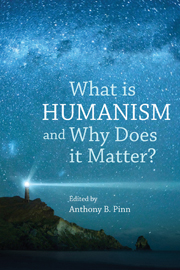Book contents
- Frontmatter
- Contents
- Preface
- Acknowledgments
- Part I What Is Humanism?
- 1 Humanism as Experience
- 2 Humanism as Guide to Life Meaning
- 3 Humanism as a Meaning Frame
- Part II Why Doest Humanism Matter?
- Part III What Do We Do With Humanism?
- Appendix: Humanist Manifestos
- Notes
- Select Bibliography
- Contributors
- Index
3 - Humanism as a Meaning Frame
from Part I - What Is Humanism?
- Frontmatter
- Contents
- Preface
- Acknowledgments
- Part I What Is Humanism?
- 1 Humanism as Experience
- 2 Humanism as Guide to Life Meaning
- 3 Humanism as a Meaning Frame
- Part II Why Doest Humanism Matter?
- Part III What Do We Do With Humanism?
- Appendix: Humanist Manifestos
- Notes
- Select Bibliography
- Contributors
- Index
Summary
WHAT KIND OF THING IS HUMANISM?
Humanism is an important phenomenon in modern society, but what kind of thing is it exactly? Very often it is regarded as an alternative to the Christian (or another) religion, and thus functionally it is said to be a “religion.” Many humanists, however, do not like this at all. They do not want to see humanism as a religion. So they look for another, more general word to capture the function of both humanism and religion. “Philosophy of life” and “world-view” have been used in this way. In the Netherlands “levensbeschouwing” (life-view) has acquired currency, even in the constitution and national laws. In the International Humanist and Ethical Union (IHEU) the phrase “life stance,” originally proposed by the British humanist Harry Stopes-Roe, has been accepted. Furthermore, investigating the modernization of society and the concomitant trends of individualization and secularization, some social scientists have proposed the term “meaning system.” Yet, I would suggest that “meaning system” sounds too systematic and complete to refer to the mostly implicit “meaning frames” people use in the daily practice of their lives. Instead, I would argue for “meaning frame” as a way of capturing what is meant by the function of humanism. In what remains of this chapter, I explain what a meaning frame is and what humanism as a meaning frame might be.
Information
- Type
- Chapter
- Information
- What is Humanism, and Why Does it Matter? , pp. 42 - 58Publisher: Acumen PublishingPrint publication year: 2013
